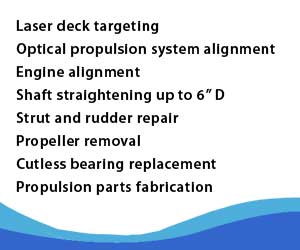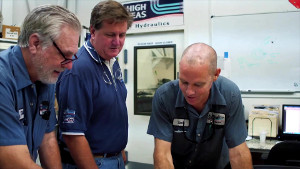Propeller Crack Testing – A “NEW” ABS Class Requirement
Earlier this year, ABS implemented a new survey requirement when a vessel is hauled for propeller work. Each time a propeller is removed and reinstalled, the entire hub of the prop should be crack tested on the vessel. The concern is that repeated torqueing of the prop hub onto the shaft taper may induce cracks.
Regardless of a vessel’s size, its propellers experience exceptional cyclic stress and fatigue. The stress can eventually result in cracks, both visible and microscopic. The fragmentation of a wheel while underway can have numerous consequences including the delay of a trip, damage to the vessel, or in rare cases, personal injury. A skipper or owner can mitigate these problems with a crack test that will detect defects before they become a bigger problem.
The red dye penetrant test is the preferred non-destructive procedure for crack testing a propeller. Depending on the volume of area to be tested, it usually can be completed within a few hours.
Although many yards or mechanics can apply dye penetrant and developer to a propeller, the skill, knowledge, and expertise truly exist in a technician’s ability to interpret the results. The ability to understand each nuance of a dye pattern can be the difference between unnecessarily replacing a wheel; or worse, not replacing one. Owners, captains, and engineers are wise to use only class ABS and Lloyds Certified level two facilities.
High Seas and Straight Line Marine is a certified Level II crack testing facility. Give us a call if you are going through an ABS survey or just want to check your props for peace of mind.




 Click to watch the video of a day at High Seas Yacht Service.
Click to watch the video of a day at High Seas Yacht Service. Click to watch Marine Industries Association of South Florida video featuring Salty Jobs at High Seas Services.
Click to watch Marine Industries Association of South Florida video featuring Salty Jobs at High Seas Services.
Comments are closed.